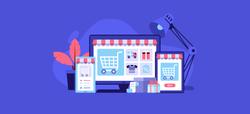In the world of e-commerce, omnichannel marketing is only growing hotter and hotter. We’ll take a look at where omnichannel marketing currently stands in e-commerce, and what you can do to get started.
To begin, what is omnichannel? Largely due to the influx of social networks and websites, customers now expect brands and product vendors to maintain a consistent, unified presence across all their platforms.
In e-commerce, omnichannel marketing is using multiple marketing channels to maintain touchpoints with customers at every stage of the buying process.
So how is omnichannel different than having different marketing platforms? In theory, it’s not. You still need social media, a website, customer service, etc.
However, omnichannel breaks down barriers and silos between data, meaning that the customer receives a seamless experience across all channels.
For instance, your customer purchases through your site, talks with your chatbot for customer support, and is remarketed to on social media after purchase for relevant products.
No matter the first step you take, you must not push off omnichannel as a passing trend. Chances are your competitors are already exploring omnichannel strategies, and customers expect it as part of your service or product offering.
Let’s take a look at some of the four major benefits of omnichannel on each e-commerce vertical below.
Channels
In omnichannel strategy, the sales channels for your e-commerce store make all the difference. With the right mix of channels, you can broaden your customer reach, gain more brand recognition, and even increase your revenue.
Think of your omnichannel strategy as physical real estate. Don’t you want the best location, where you can get traffic from consumers of all types?
As you’re building your business, ask yourself: where is my prime location? Where do I want to attract new customers, and where do I want to improve relations with my current customers?
The next step then would be to determine which channels are right for you. Let’s take a look at some common omnichannel efforts below.
- Online Store
- Social Media
- Physical Locations
- Mobile Channels
- Wholesale
- E-commerce Marketplaces
As every business is different, the channels you choose to optimize for omnichannel ecommerce are entirely up to you. To help you get started, reflect on the following questions to determine if your current channels need re-examining.
- Where does my target market spend their money?
- Which channels are best for my product?
- Which channels are best for my brand?
- Which devices do my customers use?
Additionally, a diversified channel strategy can greatly reduce risk. Keeping working channels, like Facebook Messenger – for instance – can allow you to experiment with other omnichannel strategies, like Instagram Shopping, or Mobile Messaging.
Marketing
Unfortunately, if you’ve just started your store, customers won’t find your products unless you participate in some form of advertising. Even e-commerce giant Amazon runs ads!
There’s so much to be said for providing the right message at the right time to the right audience. A consistent brand experience (i.e., omnichannel strategy) can amplify your marketing efforts, and make a massive impact on your sales.
If you’re looking to drive awareness or increase sales, take a look at the following digital marketing resources to jump-start your omnichannel strategy.
-
Google Shopping
Google Shopping ads provide you with a formidable presence in search results, and allow you to lean on search queries in order to advertise your products. -
Marketplace Advertising
Advertising on marketplaces like eBay or Amazon can offer you a boost in product sales, as these platforms already capture a web-visitors’ intent to purchase. -
Retargeting Advertising
When you retarget customers, you present them with ads that reference products that they have viewed. You can also retarget customers that have purchased goods, and that might like similar or complementary products. -
Social Media
While social media is huge for brand presence, it’s also a great advertising channel. Facebook and Instagram have countless capabilities for e-commerce advertising. -
SMS & Email
If your users are opted-in to receiving messaging from you, there’s no better way to communicate with them than via SMS and email. These platforms offer the most personal and targeted methods for connecting with your buyers.
Operations
In addition to working with your customers, you must also work with your vendors and your data to ensure that your information is as up-to-date as possible. You need accurate reporting of your inventory, as well as the ability to stay on top of any open orders.
An integrated tech stack will be your key advantage over your competitors. Imagine not knowing the status of your inventory, and selling products that you don’t currently have in stock.
This creates considerable friction in your sales pipeline, and could likely cause customers to not only never purchase from you again, but also tell their friends and family about the negative experience.
Each cog in your machine needs to be integrated with your sales and marketing channels, and communicating with one another. Remember: omnichannel is not just communication with your customers, but communication internally as well!
Fulfillment
If you want to excel in customer service, then you must think of fulfillment as an extension of your customer service offerings! After all, shipping and fulfillment are 50% of the e-commerce business.
Dedicating resources to securing an omnichannel approach to fulfillment is necessary when you’re opening new lines of ordering and communication.
If you’ve suddenly secured twice as many orders this month because you’ve added an omnichannel integration with Facebook Messenger, these numbers won’t mean anything if you can’t keep up with the shipping or fulfillment demands!
In fact, a positive experience with shipping and fulfillment is what keeps customers coming back. Shipping software or third-party logistics companies can assist with relieving some of the burden that comes with increased order volume.
Omnichannel Strategy with JivoChat and Jumpseller
With Jumpseller’s JivoChat App, you’re only a few clicks away from running an integrated omnichannel marketing strategy. JivoChat’s omnichannel messaging service helps you connect with customers faster, and across more messaging apps, like Facebook, Telegram, and Viber.
For the platforms you want to link, just simply set up the integration between JivoChat and the apps of your choice. After setting them up, these social services will be activated in your JivoChat integration.
Once the connection is established, you’ll see options for your customers to contact you on their preferred social or communication network of their choice.
If you’re just starting out with omnichannel, or looking to get ahead of your competition, using this JivoChat integration is certain to help you convert more customers across their favorite channels!
Need help with your omnichannel strategy? We’re here for you, and we make it easy. Get started selling with Jumpseller today!





